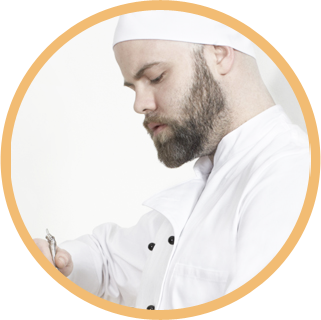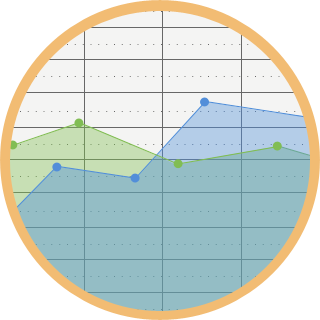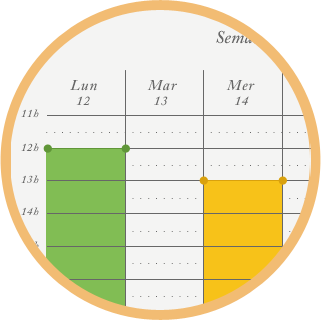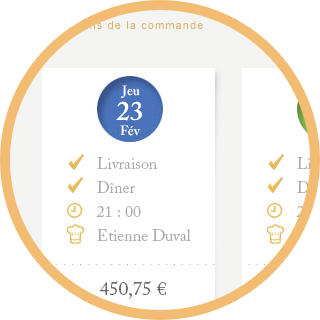La Belle Assiette
Chefs to your kitchen
take a scroll to learn more
La Belle Assiette is Europe’s first and top trending online service connecting independent chefs with their customers. Soon after launching, it received the Best E-commerce innovation award from FEVAD and Journal du Net in 2012.
“We simply knew we wanted to help independent Chefs show their talent to the world”, says Stephen Leguillon, CEO.

The website contains an extensive database of culinary talents who have either gained exclusive experience in Michelin-starred restaurants or graduated from the most prestigious cooking schools around the world. Browsing through their profiles, viewing ratings and feedback, users can make up their mind and choose the desired chef for family dinners, business lunches, cocktails, parties, or cooking classes.
Boasting sleek and beautiful design together with the easy-to-use interface, the website provides a pleasant and quick booking experience. To make a reservation, a customer only enters the date, time, and place of the occasion and gets a list of available chefs with their menus.
Offering services in 7 cities across France, the up-and-coming La Belle Assiette will shortly operate at the international scale.
How it all began
La Belle Assiette was one of the projects we put our hearts and souls into. It all started with an intriguing and catching quote request:
We are opening the internet market to those chefs who want more from their career, allowing them to deliver their delicious dishes straight to private individuals and companies.
It embodies the revolution of the food delivery market, by proposing a high-quality and freshly prepared alternative to boring mass-produced takeaways. We are connecting in real time the customers with the chefs, allowing them to order online directly from our website.
We are now looking for a talented developer to start coding this exciting adventure. After the launch in France we plan to expand to other western countries very quickly.
The whole thing sounded appealing and mouth-watering to us. We were lucky to get shortlisted right away, and after communicating and providing the client with our references, we both completely cleared up any doubts.
Stephen Leguillon, CEO, and Giorgio Ricco, COO, appeared to be the kind of product owners we could ever possibly wish for. Born entrepreneurs and fully committed to their pursuit, they constantly shared their opinions, open-mindedly listened to our pros and cons, looked into every single issue including purely technical areas, and never let us down.
It was obvious that the client knew exactly what they wanted and had thoroughly thought out every project detail.
By the start of our cooperation, the guys had prudently identified a technology stack to work with, prepared all necessary mock-ups and explicit user cases. It all helped us a lot in estimating the project time & costs and planning the development process.
We managed to very precisely evaluate the future workload which resulted in minimum changes done throughout.
The process of implementation
From the tech perspective, our main task was combining three types of functional features related to admin’s, chefs’ and customers’ profiles.
To achieve our goals, we picked a tech stack including Node.js, MongoDB, Backbone, FitText, and Less for designing the first product version.
In general, the project appeared fairly small-scale involving a back-end and a front-end developer and taking us about 3 months to accomplish.
The design part was up to the great company called Swap who delivered an excellent visual concept and properly implemented it.

Promo web site
The promo site was supposed to give both full information about the marketplace and an opportunity to easily make an order.
A user just needs to enter his/her zip code, date and time of the event. After that a person immediately gets a list of available chefs, can review their profiles, examine menus, select preferred meal ingredients, and eventually make a reservation.

Admin Backoffice
With the admin panel, we focused on providing accurate and full stats on users and orders. It was essential for the client to analyze the quality of services rendered and regularly check on customer feedback.
Another crucial feature was an opportunity for the admin to examine and approve chefs’ profiles, namely bios, photos, and menus. This way the client would be able to maintain the highest quality of the website content.
The admin’s rights also included an ability to engage in discussions to resolve any arguments or clear up ambiguities.

Chef Backoffice
We faced quite a challenge when developing proper chef backoffice functionality including the following options:
- editing profile information (bios, photos, videos, etc.);
- identifying locations to provide services at a chef is only searchable in areas he/she specifies);
- creating menus with detailed ingredients;
- differentiating menus by type (catering or private chef services, buffets or dinners, etc.);
- managing schedules by indicating dates available for reserving or already booked;
- monitoring orders & approving/rejecting them.

Customer backoffice
We wanted to provide customers with a simple and handy interface allowing them to easily search for the most suitable chefs and manage their reservations.
We made sure website users would always be able to see the list of orders and check on their current status (approved/rejected). After experiencing the service, customers are free to rate the chef as well as give feedback on the meal and the job done.
Knowledge & experience transfer
It took the team three months to accomplish the project which involved designing the first version and a bit of product maintenance and support. The next step was cooperating with the client’s onsite developers for a certain period of time, helping them understand the specifics and finally handing over the project to the other party.
The transfer went smooth and easy partly because of the project small scale, partly because we had been preparing for it since the very beginning. Moreover, we were confident of the client’s competency and knew the product would be decently maintained.
We are happy and proud to see that the project has been alive, evolving and growing actively. We still keep in touch with Stephen and Giorgio and are always excited about their progress and accomplishments. Undoubtedly, we’ll be looking forward to working with the guys again.
What lessons we have learned
Using Node.js as a complete backend solution
Working with Node.js, we realized it to be a less appropriate option. If resorting to PHP and MySQL, the development process would have gone much faster and smoother allowing to eliminate unpredictable server behaviour and multiple unexplainable errors.
Node.js certainly has its pros and advantages, but you can only benefit from them in the right place at the right time. It would have been more effective for us to work with tools better tailored for the project requirements instead of following the tech trend.
Using MongoDB
Using Node.js and MongoDB was actually one of the client’s requirements. For us, it didn’t seem the most suitable solution as these tools could be more time-consuming to work with, and they actually were.
Such a relatively tiny part as working with MongoDB clients like UMongo and RockMongo instead of regular MySQL tools also appeared to be quite disappointing. Even the client themselves happened to stuck once when they needed to do a small fix in the database, though it would be a piece of cake with MySQL. But anyway, any experience is good experience.
Parallax & FitText plugin
In spite of being an initially appealing design idea, integrating the plugin & parallax concept into the website turned out to be very time-consuming. Eventually, we had to get rid of many interface elements as they didn’t fit well to different screen resolutions. It was a crucial point as according to the analytical stats users’ devices ranged from netbooks to computers with widescreen monitors.
Oversized and high quality background images used on the page also caused us some troubles. We had to utilize them for all chefs’ profiles as well as deal with optimization and upload speed issues.
